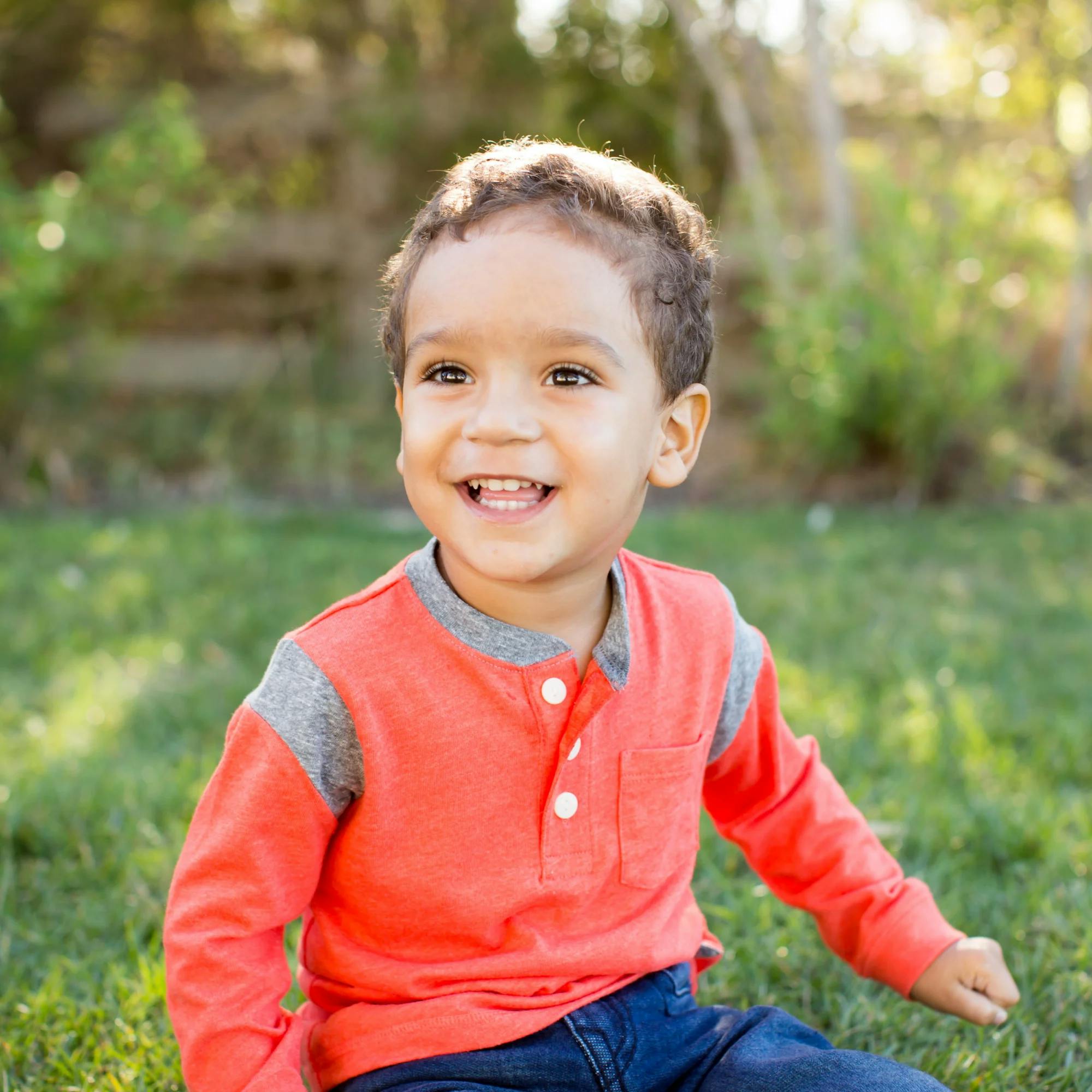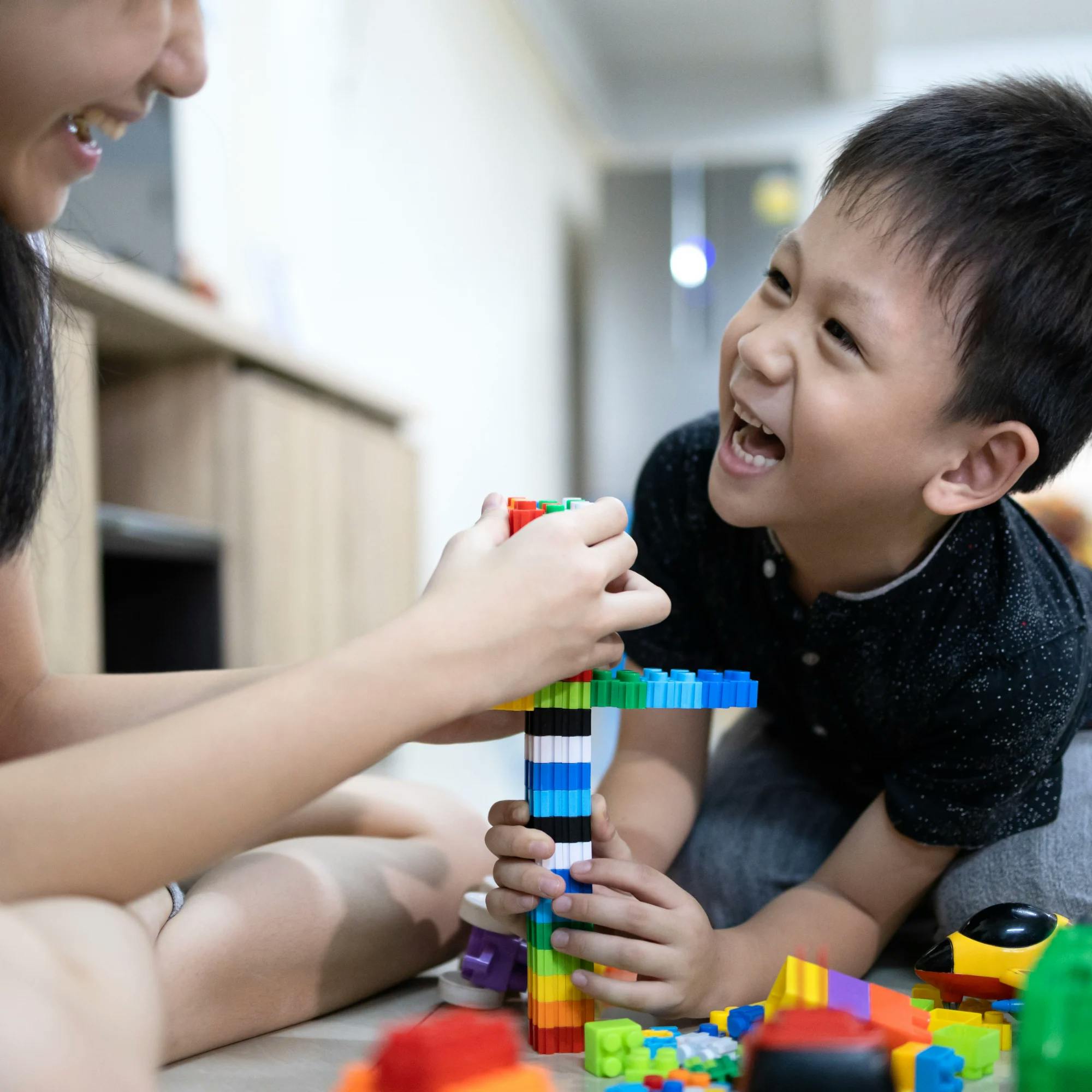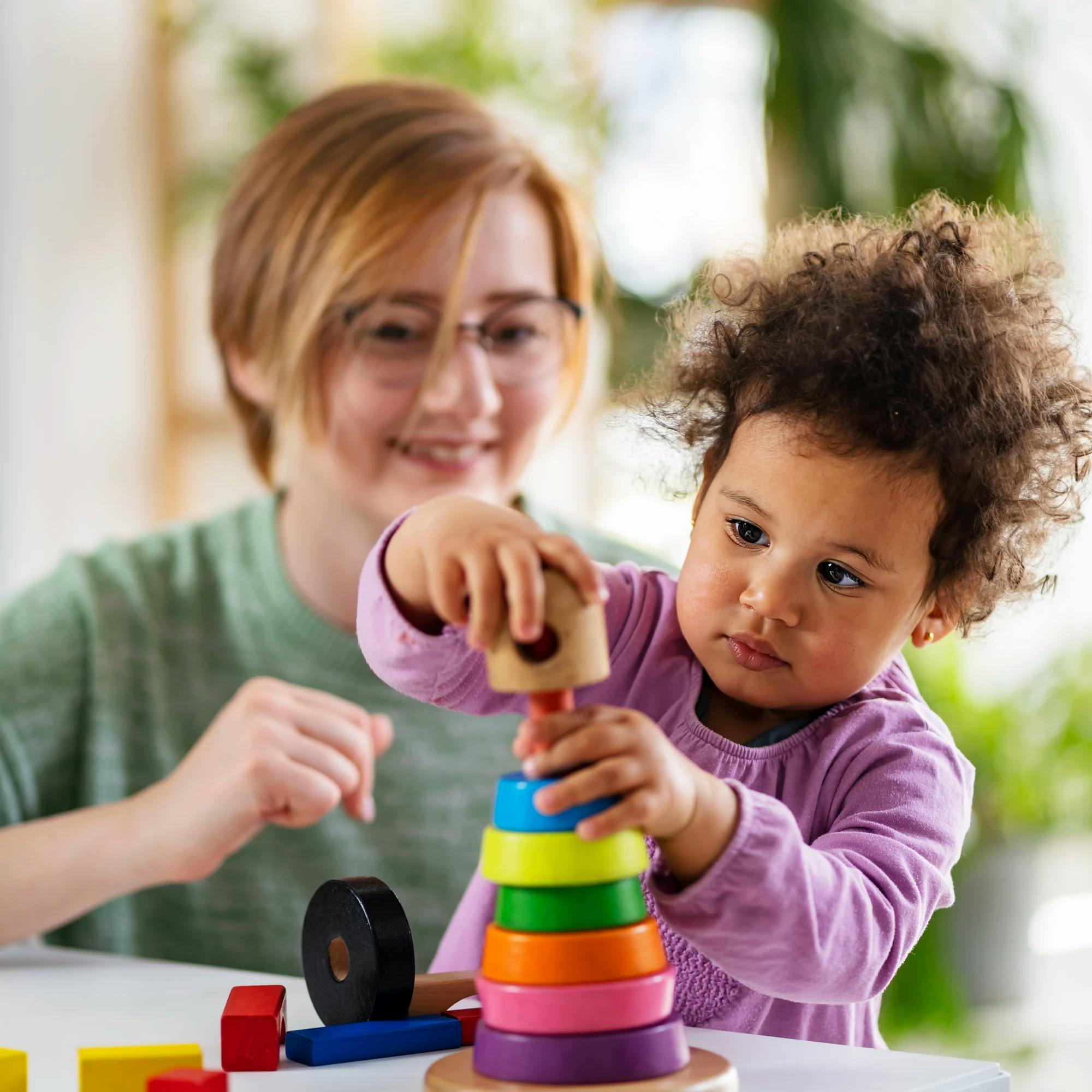When you have a toddler at home, it’s normal to watch their development to see if they’re meeting expected childhood milestones. As part of that, you may wonder if there are specific signs of autism to look for and when they might appear.
When children are 2 years old, some signs of autism may already be present. You might see them in the way your child communicates, plays, behaves, or responds to other people. In this article, we explain the possible signs of autism at age 2, how autism is diagnosed in toddlers, and how speech therapy can help support autistic kids.
Is your child on track?
Take our free screener to learn more about your child's development and whether a speech evaluation is recommended.
 Screener for children
Screener for childrenEarly signs of autism in toddlers
According to the Centers for Disease Control and Prevention (CDC), about 1 in 31 children in the United States is autistic. Boys are 3.4 times more likely to be diagnosed with autism than girls. The overall prevalence of autism is lower among non-Hispanic White children than among children of other races.
There are signs of autism related to communication, behavior, and social skills that may be present in a 2-year-old. However, keep in mind that not all autistic toddlers will have all of these signs. Every child with autism is different and develops in their own way, at their own pace.
Signs of autism at 12 months
At 12 months old, most children can immediately look in the direction of an object when you point to it. They will then look back at you and mimic your expression, such as a smile. However, in these situations, an autistic toddler may appear to ignore the person. They may also have these signs:
Little to no babbling
Little to no gesturing, such as pointing or waving
Does not respond to hearing their name


Signs of autism at 18 months
At 18 months old, most children have begun speaking. They typically have at least 5 to 10 words they use regularly and spontaneously. They often imitate words as well.
An 18-month-old will typically point at things they find interesting. They look back and forth between an object and a parent to make sure the parent is interested, too.
“Autistic toddlers will often point to an object because they want a parent to get it for them, not because they want the parent to enjoy the object with them,” says Alexis Irazoque, M.S., L/SLP, a speech-language pathologist at Expressable. You may also see these signs in your toddler:
Uses very few words, or no words at all
Overall difficulty communicating their needs and desires
Does not play make-believe or pretend games
Signs of autism at 24 to 36 months
There are a variety of other signs of autism that may appear in a 2-year-old:
As a result of speech delays, uses challenging behaviors (such as crying or tantrums) instead of words or gestures to communicate what they want
Difficulty understanding conversations and instructions; may respond to a question by repeating it rather than answering
Consistently repeats words or phrases they just heard or that they heard days earlier, almost as if they’re echoing speech (this is called echolalia, which is a form of gestalt language processing)
Speaks in a robotic tone of voice that lacks inflection or intonation
Lacks interest in the world around them; for example, doesn’t respond when you point out an object, like a plane flying overhead
Difficulty with sharing toys or taking turns
Avoids eye contact
Prefers not to be touched, held, or cuddled
Dislikes certain sounds, smells, or textures (for example, may choose foods based on texture)
Becomes distressed by a change in daily routine
Repeats unexpected behaviors, such as lining up their toys, rocking their head back and forth, spinning their body, or having trouble staying still

Does a speech delay mean autism?
“While a delay in spoken language is a sign of autism, having a speech delay does not mean a child is autistic,” Irazoque says. A speech delay is typically present with autism. However, a speech delay can exist separately from autism.
There are other speech-related signs of autism that may be noticed at age 2. These include:
Not pronouncing simple, single words by age 16 months
Inability to use simple, two-word phrases
Loss of language skills that the child previously had
Using echolalia, or repeating phrases in order to communicate


Can autism be diagnosed at age 2?
Diagnosing autism can be challenging. Your doctor will look at your child’s developmental history, as well as their communication and behavior, to make a diagnosis.
While autism can sometimes be diagnosed at age 18 months or younger, by age 2 most diagnoses performed by qualified professionals are reliable. However, some children don’t receive a diagnosis until they’re older, even into their teen or adult years.
How is autism diagnosed in toddlers?
There are several steps involved in an autism diagnosis. The CDC outlines each of these screening steps. Ensuring that your child is properly monitored, screened, evaluated, and diagnosed is essential to getting them the care they need to live a productive and fulfilling life.
Different experts can diagnose autism. These professionals may include psychologists, pediatricians, and neurologists. Psychologists are a big part of the diagnostic process.
According to the American Psychological Association (APA), a psychologist will likely use the following information to help with diagnosing autism:
Talking with the child
Observing the child’s behavior
Tests of cognitive and language abilities
Medical tests to rule out other conditions
Interviews with parents, teachers, or other adults who can answer questions about the child’s social, emotional, and behavioral development


How is autism treated in toddlers?
Speech therapy is an important part of treatment for autistic people of all ages. Challenges with communication and speech, like all aspects of autism, vary from person to person. At age 2, some autistic kids may not be talking at all. Others may speak, but they still can't communicate their needs clearly.
Speech-language pathologists, also known as speech therapists, play a key role in supporting people with autism. Speech therapy can help autistic people become better communicators and improve both their verbal and nonverbal communication skills. This can help them form relationships with others and function better in day-to-day life.
Find the right speech therapist for your child
We'll match you with a licensed speech therapist who's experienced in your child's needs and available when you are.
 Get started
Get startedA speech therapist will assess and evaluate your child's communication strengths and challenges, and develop a treatment plan tailored to their needs. Your speech therapist will find ways to engage with your child during sessions, whether that involves play, storytime, or movement activities. “For example, let’s say the child is working on requesting an item using words or signs,” says Irazoque. “The speech therapist may present something interesting, like bubbles, and have the child either imitate the word or make the sign for ‘more’ or ‘please.’”
Some children may be nonverbal. Speech therapy can be beneficial for nonspeaking toddlers as well. There are many types of assistive devices and technologies to help them communicate. These tools are called augmentative and alternative communication (AAC). Your speech therapist will let you know whether your child would benefit from AAC and teach you how to use it. Examples of AAC methods include:
Picture exchange communication system (PECS)
Communication applications on tablets or iPads
Speech output devices (such as Dynavox)


What to do if you think your toddler might have autism
If you have any questions at all about your child’s development, it’s always OK to talk to your pediatrician. You can also contact a speech therapist. You can take our free online speech and language screener to see if an evaluation is recommended for your child, or get matched with a speech therapist here.
Frequently asked questions (FAQs)
At what age is autism first noticed?
Signs of autism can appear as early as 12 months. An autistic 1-year-old may not babble, point, or wave much, or they may not respond when they hear their name. At 18 months, they may use very few words, have difficulty with overall communication, or not be interested in make-believe games. If you notice these signs, try our free screener to check your child's communication development.
Does a speech delay mean my child has autism?
A speech delay can be a sign of autism, but it doesn't always mean your child is autistic. Speech delays can have a variety of causes. If you're worried about your child's speech, get matched with a speech therapist who can help you understand what's going on and what to do next.
How does a 2-year-old with autism play?
Autistic toddlers tend not to pretend-play. They may have difficulty with sharing toys or taking turns. They may prefer to play alone and have intense interests in certain things, such as a specific toy or character. Autistic toddlers may also repeat unexpected behaviors, such as lining up their toys, or focusing more on one aspect of a toy (the wheels of a car) rather than playing with it as expected (driving the car around).
What does mild or high-functioning autism look like in a 2-year-old?
Each autistic person is different, but toddlers with mild autism may struggle only in certain situations. They might have trouble interacting with other people or joining in a back-and-forth conversation. They may prefer routines and have difficulty switching between activities. They may also have sensory issues, or sensitivities to certain sounds, smells, or textures.
Can autism be diagnosed in toddlers?
Yes, by age 2 most diagnoses performed by qualified professionals are reliable. To diagnose autism, doctors look at a child's development, how they communicate, and how they behave. Specialists such as psychologists, pediatricians, and neurologists can make the diagnosis. If you think your child might be autistic, our free screener can help you decide if you need to see a specialist.
How can I help my child communicate if they're nonverbal?
AAC methods, like sign language, picture cards, and communication apps, help children who have trouble speaking. If you think your child might benefit from AAC, a speech therapist can help you choose the best tools.
Key takeaways
A 2-year-old may have signs of autism related to communication, behavior, and social skills. However, not all autistic toddlers will have all of these signs. Every child with autism is different and develops in their own way.
Having a speech delay does not mean a child is autistic, although a delay in spoken language is a sign of autism.
While autism can sometimes be diagnosed at age 18 months or younger, by age 2 most diagnoses done by qualified professionals are reliable.
Speech therapy is an important part of treatment for autistic people of all ages. Speech therapy can help autistic toddlers improve both their verbal and nonverbal communication skills.
An important note: We believe that when speaking about any community as a whole, the best approach is to prioritize that community’s voices, needs, and preferences. Within the larger autism community, the current language preference is identity-first (e.g., "autistic children"), which is why we use that language in our content. Expressable is committed to listening to and learning from the populations we serve. If and when their preferences change, we’ll adjust our approach accordingly.
How Expressable Can Help
Concerned your child isn't reaching age-expected milestones? Looking for communication support from a professional? Expressable is a national online speech therapy practice serving children and adults. We treat all major areas of communication and feeding, offer flexible hours including evenings and weekends, and accept most major health insurance plans. We’re proud to have earned more than 3,000 5-star reviews from our clients (4.9/5 average).
Our therapy model is centered on parent and caregiver involvement. Research proves that empowering caregivers to participate in their loved one’s therapy leads to better outcomes. That’s why we combine live, 1-on-1 speech therapy with personalized education and home practice activities for faster progress.
Communication is more than words. It’s how we share how we feel and show who we are. We’re here to help you or your child do just that.
 Abby Barnes, M.S., CCC-SLP
Abby Barnes, M.S., CCC-SLP









